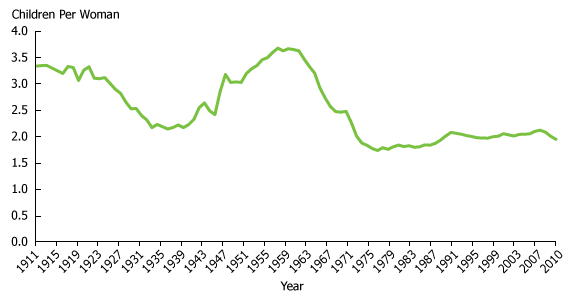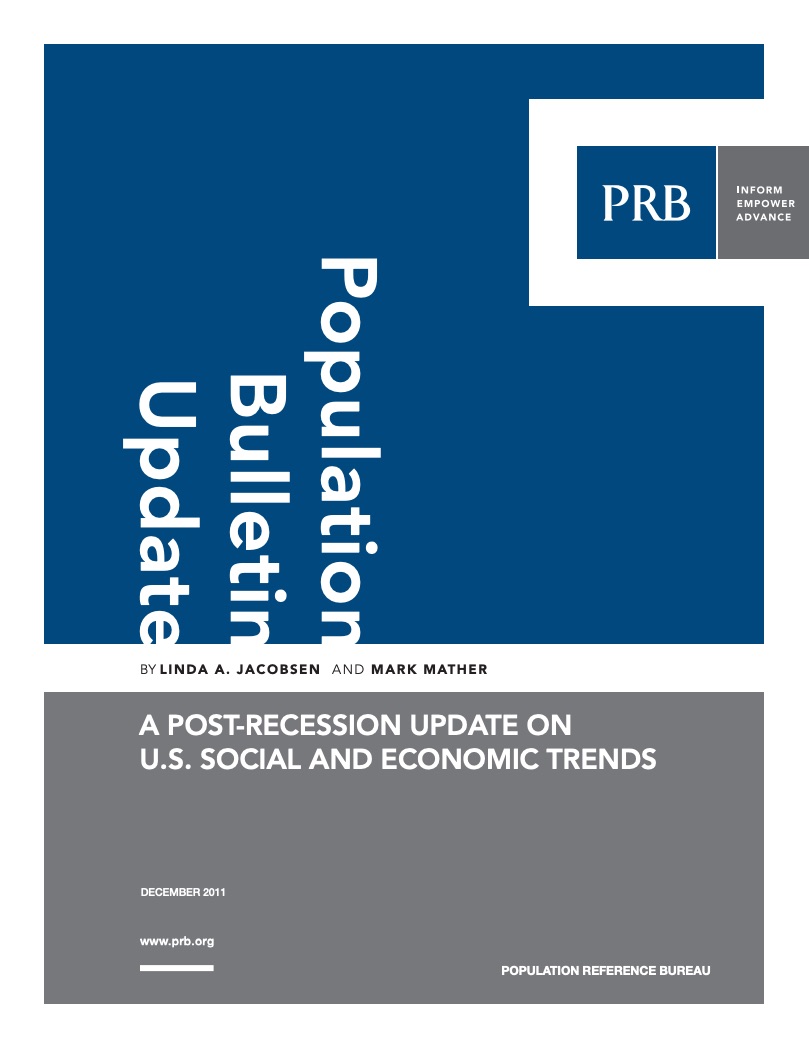
A Post-Recession Update on U.S. Social and Economic Trends
Date
November 27, 2011
Author
This Population Bulletin Update is a follow-up to PRB’s 2010 Population Bulletin, “U.S. Economic and Social Trends Since 2000,” and provides new data and analysis on the ongoing impact of the Great Recession on unemployment, poverty, housing, education, the status of young adults, and the birth rate in the United States.
The Continuing U.S. Recession and the Birth Rate
by Carl Haub
(December 2011) As we near the end of 2011, the global recession is still with us, and so too is the economic downturn in the United States.
The 2010 Population Bulletin, “U.S. Economic and Social Trends Since 2000,” speculated that the economic climate in the United States might result in a decrease in the birth rate. Past economic crises have resulted in some remarkable swings in U.S. birth rates over the past 80 years (see figure).
U.S. Total Fertility Rate, 1911-2010

Source: National Center for Health Statistics.
Record low points occurred during the Great Depression in the 1920s and 1930s and during the “oil shock” inflationary period of the 1970s. It now seems clear that something similar is happening, although to date, the decline is less dramatic than in those two periods.
In 1976, the U.S. total fertility rate (the average number of children per woman, or TFR) fell to its lowest point in U.S. history, 1.7 children per woman. The TFR had been declining rapidly in the latter half of the 1960s from its baby-boom peak of 3.7 children per woman. But the 1970s was also a time of profound social change. Feminism was taking hold as women sought roles beyond that of homemakers. Added to that was the 1973 Supreme Court decision in Roe v. Wade that legalized abortion. The economy was in stagflation, where prices rose but incomes did not.
Today, only one thing seems to be influencing birth rates—the recession.
The TFR fell from 2.12 children in 2007 to 2.01 in 2009, and may be as low as 1.93 for 2010, according to preliminary estimates. Although the final TFR is not yet available, the decline clearly is there. By age, the largest percentage declines were among women ages 15 to 29, a group that accounted for 60 percent of all births in 2009. The assumption that women delayed beginning a family with a resultant sharper drop for first births proved untrue. First births accounted for 40 percent of all births in both 2007 and 2009.
Among racial and ethnic groups, however, there were significant differences in the decline. Among Hispanics, the TFR fell from 3.0 to 2.7 from 2007 to 2009. Among non-Hispanic whites, the decrease was much less, from 1.9 to 1.8 children per woman; a similar small decrease in the TFR was evident among non-Hispanic blacks, from 2.1 to 2.0.
Birth rate trends for 2011 will be released in late December by the U.S. National Center for Health Statistics. But clearly, the recession is still very much with us: Even though the national unemployment rate in 2011 has been lower in every month than it had been in 2010, the rate is still around 9 percent.
Previous page:
More Young Adults in U.S. Postponing Marriage, Living at Home, Disconnected From Work and School
Carl Haub is a senior demographer at the Population Reference Bureau.

 ">
">